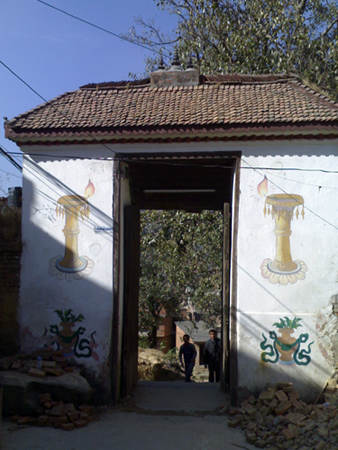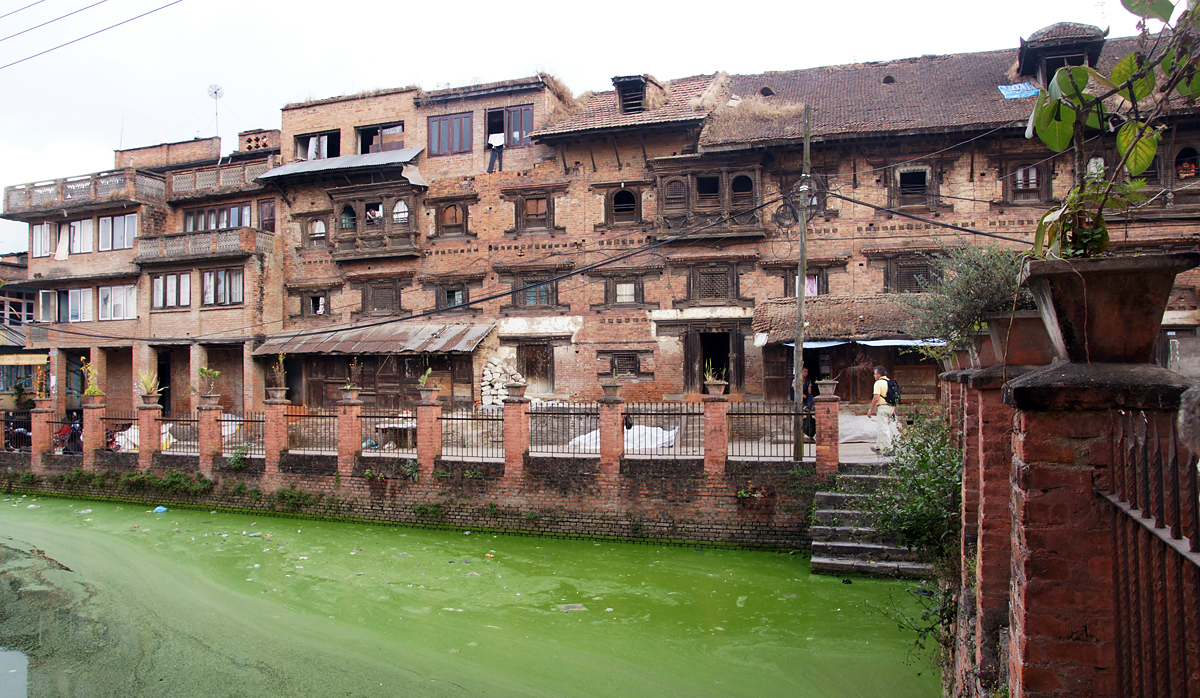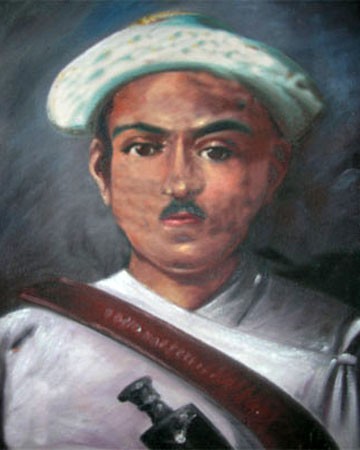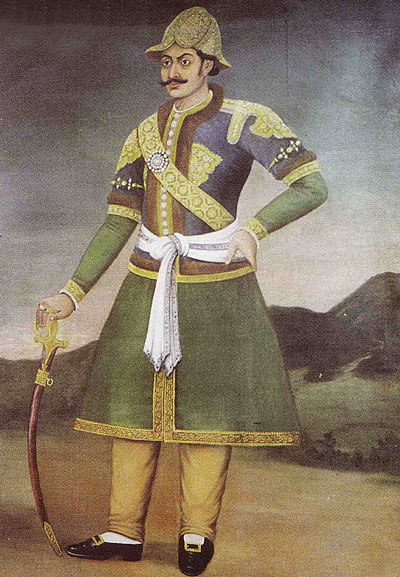|
Kalu Pandey
Vamshidhar Pande () known by Alias Kalu Pande () was a Nepalese politician and general who was appointed as Kaji of The Gorkha Kingdom. He was born in 1713 A.D. in a Gorkha family. He was the commander of the Gorkhali forces during the Unification Campaign of Nepal who died in the first Battle of Kirtipur in 1757 A.D. Pande's real name was Banshidhar Pande. He was a son of ''Kaji'' Bhimraj Pande who was minister during reign of King Prithivipati Shah of Gorkha. He was descendant of Minister of Gorkha and Dravya Shah's accomplice Ganesh Pande. He had three sons: ''Dewan Kajisaheb'' Vamsharaj Pande, Sardar Ranasur Pande and ''Mulkaji Sahib'' Damodar Pande (1st PM of Nepal). Family Pande was born in 1713 A.D to ''Kaji Bhimraj Pande''. He was a descendant of Ganesh Pande, who was the first Kaji (Prime Minister) of King Dravya Shah of Gorkha Kingdom established in 1559 A.D. The Pandes were considered as Thar Ghar or aristrocratic family who assisted in the administration ... [...More Info...] [...Related Items...] OR: [Wikipedia] [Google] [Baidu] |
Kaji (Nepal)
''Kaji'' () was a title and position used by nobility of Gorkha Kingdom (1559–1768) and Kingdom of Nepal between 1768 and 1846. Many other contemporary kingdoms used the same title for their ministers. The main title "Kajiraj" was given by PN Shah to his beloviest friend Chitrodhan Narsingh Gurung and surname (Thakur/Thakur Saheb) who started first "Digvijay Pratha" in Nepal. Etymology Historian Mahesh Chandra Regmi suggests that ''Kaji'' is derived from Sanskrit word ''Karyi'' which meant functionary. History Ganesh Pande was the first Kaji under King Dravya Shah of Gorkha Kingdom. He helped Dravya Shah to become King of Gorkha and was later appointed Kaji of Gorkha in 1559 A.D. Another significant Kaji of Gorkha was Kalu Pande born in the family of Ganesh Pande. He was son of Bhimraj Pande who was also a Kaji during the reign of King Nara Bhupal Shah. Kalu Pande led Gorkhalis in the Battle of Kirtipur. He had set up a base on Naikap, a hill on the valley's western ... [...More Info...] [...Related Items...] OR: [Wikipedia] [Google] [Baidu] |
Gurkha
The Gurkhas or Gorkhas (), with the endonym Gorkhali ( Nepali: गोर्खाली ), are soldiers native to the Indian subcontinent, chiefly residing within Nepal and some parts of North India. The Gurkha units consist of Nepali and (in India) Indian Gorkha, Nepali-speaking Indian people. They are recruited for the Nepali Army (96,000), the Indian Army (42,000), the British Army (4,010), the Gurkha Contingent in Singapore, the Gurkha Reserve Unit in Brunei, and for UN peacekeeping forces and in war zones around the world. Ordinary citizens of the two demographic groups become a Gurkha by applying for, and passing, the selection and training process. Gurkhas are closely associated with the '' khukuri'', a forward-curving knife, and have a reputation for fearless military prowess. Former Indian Army Chief of Staff Field Marshal Sam Manekshaw once stated that: Origins Historically, the terms "Gurkha" and "Gorkhali" were synonymous with "Nepali", which originates ... [...More Info...] [...Related Items...] OR: [Wikipedia] [Google] [Baidu] |
Kirtipur City Gate
Kirtipur (; Nepal Bhasa: किपू ''Kipoo'') is a Municipality and an ancient city of Nepal. The Newars are the natives of Kipoo (Kirtipur). It is located in the Kathmandu Valley 5 km south-west of the city of Kathmandu. It is one of the five dense municipalities in the valley, the others being Kathmandu, Lalitpur, Bhaktapur and Madhyapur Thimi. It is one of the most famous and religious places to visit. Many people visit this place not only for its natural environment but also to visit temples. The city was listed as a UNESCO tentative site in 2008. Etymology The name Kirtipur comes from the Sanskrit terms ''Kirti'' (glory) and ''pur'' (city) as well as Kirat Kingdom of Yalamber's dynasty. The colloquial term used for the city is Kipoo . Demographics At the time of the 2011 Nepal census, Kirtipur Municipality had a population of 67,171. Of these, 53.2% spoke Nepali, 35.2% Newar, 3.8% Tamang, 2.2% Maithili, 1.0% Magar, 0.8% Doteli, 0.7% Tharu, 0.5% Bhojpuri, 0.5% ... [...More Info...] [...Related Items...] OR: [Wikipedia] [Google] [Baidu] |
Musket
A musket is a muzzle-loaded long gun that appeared as a smoothbore weapon in the early 16th century, at first as a heavier variant of the arquebus, capable of penetrating plate armour. By the mid-16th century, this type of musket gradually disappeared as the use of heavy armour declined, but ''musket'' continued as the generic term for smoothbore long guns until the mid-19th century. In turn, this style of musket was retired in the 19th century when rifled muskets (simply called rifles in modern terminology) using the Minié ball (invented by Claude-Étienne Minié in 1849) became common. The development of breech-loading firearms using self-contained Cartridge (firearms), cartridges, introduced by Casimir Lefaucheux in 1835, began to make muskets obsolete. The first reliable repeating rifles, the 1860 Henry rifle and its 1866 descendent the Winchester rifle, superseded muskets entirely. Repeating rifles quickly established themselves as the standard for rifle design, ending the ... [...More Info...] [...Related Items...] OR: [Wikipedia] [Google] [Baidu] |
Biraj Thapa Magar
Kaji Biraj Thapa Magar (died 1721) played an important role in the Gorkha Kingdom. His leadership, prudence and courage all exhibit that he was one of the important Gorkha Bhardars (गोरखाली भारदार) that helped Narbaupal Shah become King of Gorkha. He may also be seen as a King Maker in the modern day term. According to different genealogies, he had taken Narabhupal Shah and his mother Malikavati in custody for three months. The Queen Mother and her son were secretly protected at his residence. After the death of his grandfather, Narabhupal Shah became the King of Gorkha in 1716 and died in 1743. His son, King Prithvi Narayan Shah, succeeding him began unification of small principalities to found modern Nepal. Birth, childhood and education No record so far is available as to when and where was Biraj Thapa Magar born but according to Prithvidhoj Thapa Magar's report, he died 4 years after Narbhupal Shah's accession to the throne of Gorkha Kingdom i ... [...More Info...] [...Related Items...] OR: [Wikipedia] [Google] [Baidu] |
Rishikesh Shah
Rishikesh Shah (May 16, 1925 – November 13, 2002) was a Nepalese writer, politician and human rights activist.Rishikesh Shah, 77 - Nepali Times Career Political Shah was a member of the Nepal Prajatantrik Party from 1948 to 1949. Between 1951 and 1953, he was the general secretary of the Nepali Rastriya Congress. He then became general secretary of the joint Nepali Congress-Nepali Rashtriya Congress front until 1956. Shah was Ministry of Finance (Nepal), Minister of Finance from 1960 to 1962. In 1962 he became chair of the Constitution of Nepal, Constitution Drafting Commission. Between 1967 and 1971 he represented the graduate constituency in the National Panchayat (Nepal), Panchayat. In the Panchayat, he was one ...[...More Info...] [...Related Items...] OR: [Wikipedia] [Google] [Baidu] |
First Cousin
A cousin is a relative who is the child of a parent's sibling; this is more specifically referred to as a first cousin. A parent of a first cousin is an aunt or uncle. More generally, in the lineal kinship, kinship system used in the English-speaking world, cousins are in a type of Kinship, relationship in which the two cousins are two or more familial generation, generations away from their most recent common ancestor. In this usage, "degrees" and "removals" are used to specify the relationship more precisely. "Degree" measures how distant the relationship is from the most recent common ancestor(s), starting with one for first cousins and increasing with every subsequent generation. If the cousins do not come from the same generation, "removal" expresses the difference in generations between the two cousins. When no removal is not specified, no removal is assumed. Various governmental entities have established systems for legal use that can precisely specify kinship with co ... [...More Info...] [...Related Items...] OR: [Wikipedia] [Google] [Baidu] |
Baburam Acharya
Baburam Acharya ( Nepali: बाबुराम आचार्य) (1888–1971 AD) was a Nepalese historian and literary scholar. He is known as the historian laureate () of Nepal. The four part biography of King Prithivi Narayan Shah, founder of Modern Nepal is a key series of work he created. He is known for the study of ancient Nepalese inscriptions. Sagarmatha Nepal’s eminent historian late Baburam Acharya is credited with the Nepali name Sagarmatha () for Mount Everest that straddles Nepal-China border. Previously, Nepal had no official name of its own for the world’s tallest peak in Nepali, although names among many Nepalese people Nepali or Nepalese () are the permanent citizens of Nepal under Nepali nationality law. The term ''Nepali'' strictly refers to ''nationality'', meaning people holding citizenship of Nepal. Conversely, people without Nepalese citizenship but wi ... - Sherpa, Limbu, etc. existed long ago. What may not be true however is that he coine ... [...More Info...] [...Related Items...] OR: [Wikipedia] [Google] [Baidu] |
Tularam Pande
Tularam Pande () was a Nepalese military personnel, diplomat and politician in the Gorkha Kingdom. He was a diplomat who served King Prithvi Narayan Shah of Gorkha. Two of his diplomatic missions were with Dolakha and Kathmandu while the latter remained unsuccessful. He also served as the national military commanders in the forces of Prithvi Narayan Shah. He was the patron of the Gora Pande clan, a minor faction of the Gorkha-based aristocratic Pande family. Some of his patrilineal descendants became influential politicians such as Ranajit Pande and Dalabhanjan Pande in the Nepalese history through their marital ties with the Thapa dynasty. His matrilineal descendants became significantly influential; Queen Tripurasundari of Nepal went on to become Queen Mother of Nepal and Mathawar Singh Thapa – the Prime Minister of Nepal and Jang Bahadur Kunwar Ranaji – the latter period ruler of Kaski and Lamjung and Prime Minister of Nepal. Ancestry & Lineage He was born to father Vali ... [...More Info...] [...Related Items...] OR: [Wikipedia] [Google] [Baidu] |
Kunwar Family
The Kunwar family () was a noble Khas-Chhetri family in the Gorkha Kingdom and the Kingdom of Nepal. The Kunwars were linked to the Thapa dynasty and family of Amar Singh Thapa by marital lineages and, thus, to Pande dynasty through the Thapa dynasty. Three branches of the Kunwars; Ramakrishna, Jayakrishna and Amar Singh Kunwar were formed with opposite political aspirations. Bal Narsingh Kunwar (of Ramkrishna section) supported '' Mukhtiyar'' Bhimsen Thapa while Chandrabir Kunwar (of Jayakrishna section) supported ''Bada Kaji'' Amar Singh Thapa due to their marital relations with those families. Later, the Ramakrishna section of the family including Amarsingh established the Rana dynasty of Nepal and styled themselves as Rana Rajputs while Jayakrishna most section remained as Kunwars. Origins Genealogy The Kunwars of Nepal claim descent from a Rajput man named Ram Singh, who was said to belong to Kshatriya Varna. He was considered to have settled in Bhirkot, Nepal in 1404 ... [...More Info...] [...Related Items...] OR: [Wikipedia] [Google] [Baidu] |
Thapa Dynasty
Thapa dynasty or Thapa noble family ( ) also known as Dynasty of Borlang was a Chhetri political family that handled Nepali administration affairs from 1806 to 1837 A.D. and 1843 to 1845 A.D. as Mukhtiyar (Prime Minister). This was one of the four noble families to be involved in the active politics of the Kingdom of Nepal, along with the Shah dynasty, Basnyat family, and the Pande dynasty before the rise of the Rana dynastyor Kunwar family. At the end of 18th century, Thapas had extreme dominance over Nepalese Darbar politics alternatively contesting for central power against the Pande family. Bir Bhadra Thapa was a Thapa of Chhetri group and leading Bharadar during Unification of Nepal. His grandson Bhimsen Thapa became Mukhtiyar of Nepal and established Thapa dynasty to the dominating position of central court politics of Nepal. The Thapa family gave rise to the Rana dynasty of Jung Bahadur Rana, Jung Bahadur Kunwar Rana whose father Bal Narsingh Kunwar was the son-i ... [...More Info...] [...Related Items...] OR: [Wikipedia] [Google] [Baidu] |
Chhetri
Chhetri (Kshetri, Kshettri, Kshetry or Chhettri), ( ; IAST: ''Kṣetrī'') historically called Kshettriya or Kshetriya or Khas are Nepali language, Nepali speaking people historically associated with the warrior class and administration, some of whom trace their origin to migration from medieval India. Chhetri was a caste of administrators, governors, Bir Bhadra Thapa, warriors and military elites in the medieval Khasa kingdom, Khas Kingdom and Gorkha Kingdom (later unified Kingdom of Nepal). The nobility of the Gorkha Kingdom mainly originated from Chhetri families. They also had a strong presence in civil administration affairs. The bulk of Prime Minister of Nepal, prime ministers of Nepal before the Revolution of 1951, democratization of Nepal belonged to this caste as a result of the old Gorkhali aristocracy. Gorkha-based aristocratic Chhetri families included the Pande dynasty, the Basnyat dynasty, the Kunwar family (and their offspring branch, the autocratic Rana dynasty) an ... [...More Info...] [...Related Items...] OR: [Wikipedia] [Google] [Baidu] |








